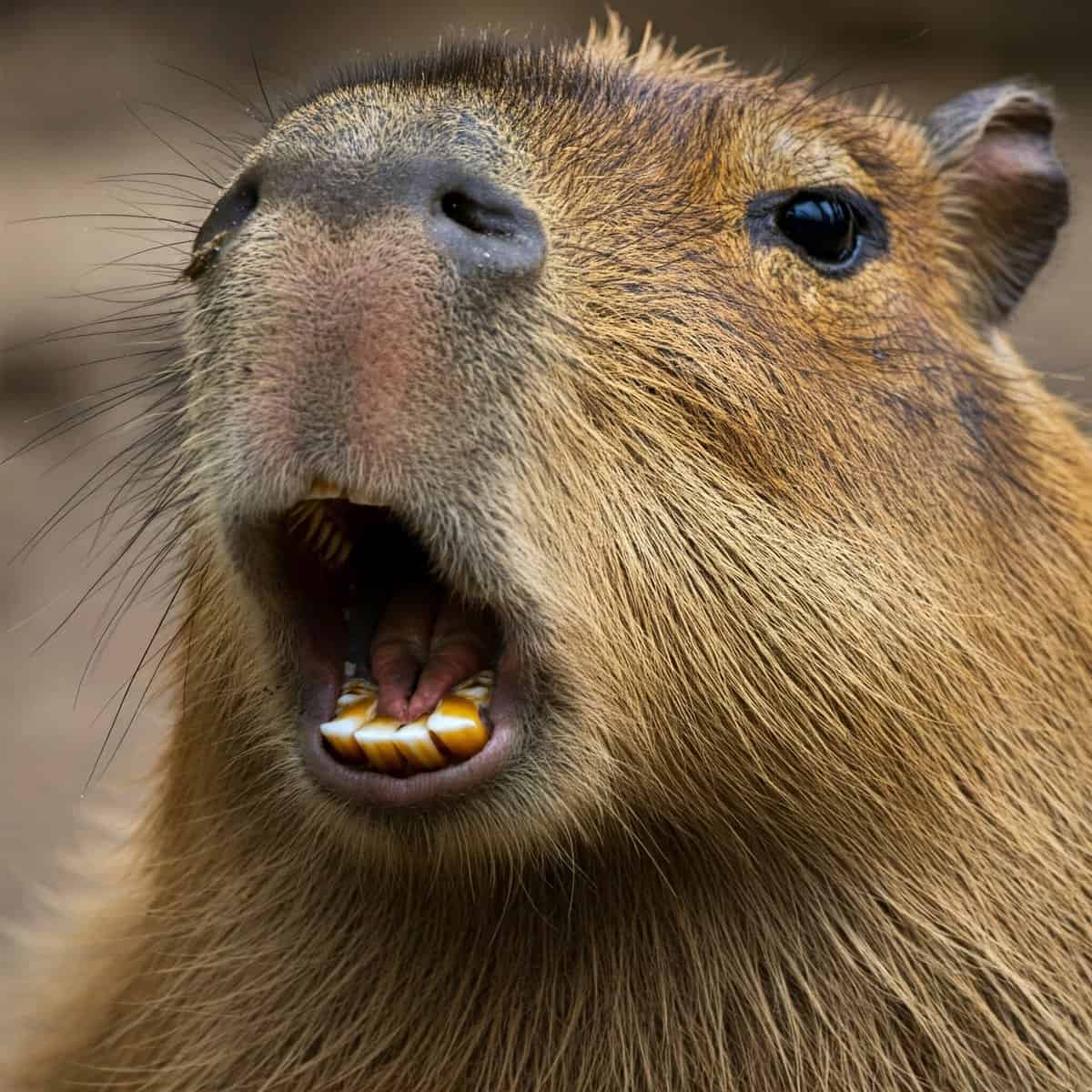Unleashing the Power of the Capybara’s Ever-Growing Teeth: A Closer Look at Nature’s Secret Weapon
The capybara, also known as Hydrochoerus hydrochaeris, is the largest rodent in the world. Native to South America, these semi-aquatic mammals are known for their large size, webbed feet, and unique dental structure. Capybaras are social animals that live in groups near bodies of water, where they can swim and forage for aquatic plants. They are herbivores, feeding on a variety of grasses and aquatic vegetation. Capybaras are also known for their gentle and docile nature, making them popular attractions in zoos and wildlife parks around the world.
Capybaras have a lifespan of around 8-10 years in the wild, but they can live up to 12 years in captivity. They are highly adaptable animals, able to thrive in a variety of habitats, from grasslands to tropical forests. Capybaras are also excellent swimmers, using their webbed feet to navigate through water with ease. Their unique dental structure plays a crucial role in their ability to forage for food and survive in their natural environment.
The Unique Dental Structure of Capybaras
Capybaras have a set of teeth that is unlike any other mammal. Their incisors are constantly growing, and they lack canine teeth. Instead, they have a set of large molars that are well-suited for grinding tough vegetation. The incisors of capybaras are open-rooted, meaning that they continue to grow throughout the animal’s life. This unique dental structure allows capybaras to continuously wear down their teeth as they feed on tough grasses and aquatic plants.
The dental formula of capybaras is 1/1, 0/0, 1/1, 3/3, for a total of 20 teeth. Their incisors are large and orange in color, while their molars are flat and ridged for grinding. The lack of canine teeth is a unique adaptation that sets capybaras apart from other mammals. This dental structure is well-suited for their herbivorous diet and allows them to efficiently process the tough vegetation that makes up the majority of their diet.
How Capybaras Use Their Teeth in the Wild
In the wild, capybaras use their teeth primarily for foraging and feeding. Their incisors are well-suited for cutting through tough grasses and aquatic plants, while their molars are used for grinding and processing food. Capybaras are known to spend a significant amount of time grazing on grasses and aquatic vegetation near bodies of water. Their ability to continuously wear down their teeth as they feed allows them to efficiently process the tough plant material that makes up the majority of their diet.
Capybaras are also known to use their teeth for grooming and social interactions within their groups. They will often engage in mutual grooming, using their incisors to remove parasites and debris from each other’s fur. This behavior helps to strengthen social bonds within the group and maintain overall hygiene. The unique dental structure of capybaras plays a crucial role in their ability to survive and thrive in their natural environment.
Challenges of Constantly Growing Teeth
While the constantly growing incisors of capybaras are well-suited for their herbivorous diet, they also present some challenges. If not worn down properly, the incisors can become overgrown and cause issues with feeding and overall health. Overgrown incisors can lead to malocclusion, where the teeth do not meet properly when the animal bites down. This can result in difficulty eating and potential dental issues such as tooth decay and infection.
In the wild, capybaras are able to naturally wear down their teeth through constant grazing on tough vegetation. However, in captivity, where access to natural forage may be limited, there is a risk of overgrown incisors. This can lead to the need for regular dental care and maintenance by veterinarians to ensure the overall health and well-being of captive capybaras.
Adaptations for Managing Teeth Growth
Capybaras have several adaptations that help them manage the constant growth of their teeth. Their diet of tough grasses and aquatic plants naturally wears down their incisors as they feed. Additionally, capybaras have a unique chewing motion that helps to grind down their molars and maintain proper dental health. This chewing motion involves both vertical and horizontal movements, allowing them to efficiently process tough plant material.
In captivity, it is important to provide capybaras with access to a variety of tough vegetation to ensure proper dental wear. Additionally, regular dental check-ups by veterinarians can help to monitor the growth of their teeth and address any issues that may arise. By understanding the unique dental needs of capybaras, caretakers can ensure that these animals receive the proper care and attention to maintain their dental health.
Human Implications and Research
The unique dental structure of capybaras has implications for human research and dentistry. The constantly growing incisors of capybaras have been studied for their potential applications in regenerative medicine and tissue engineering. Researchers have looked at the cellular mechanisms that allow capybaras to continuously grow their teeth throughout their lives, with the hope of applying this knowledge to human dental health.
Studying the dental structure of capybaras can also provide insights into the evolution of mammalian teeth and how different species have adapted to specific diets and environmental conditions. By understanding the unique adaptations of capybaras, researchers can gain a better understanding of how animals have evolved to thrive in their natural habitats.
Conservation and Care for Capybaras
Conservation efforts for capybaras focus on protecting their natural habitats and ensuring that they have access to the resources they need to thrive. This includes preserving wetland areas and grasslands where capybaras live, as well as addressing threats such as habitat loss and hunting. Additionally, efforts are made to educate local communities about the importance of preserving capybara populations and their natural habitats.
In captivity, it is important to provide capybaras with proper dental care to ensure their overall health and well-being. This includes providing access to a variety of tough vegetation for proper dental wear, as well as regular dental check-ups by veterinarians. By understanding the unique dental needs of capybaras, caretakers can ensure that these animals receive the proper care and attention to maintain their dental health.
In conclusion, the unique dental structure of capybaras plays a crucial role in their ability to survive and thrive in their natural environment. Their constantly growing incisors and lack of canine teeth are adaptations that allow them to efficiently process tough vegetation and maintain overall dental health. By understanding the dental needs of capybaras, researchers can gain insights into mammalian evolution and potential applications for human dentistry. Conservation efforts focus on protecting capybara populations and ensuring that they receive proper care in captivity to maintain their overall health and well-being.

